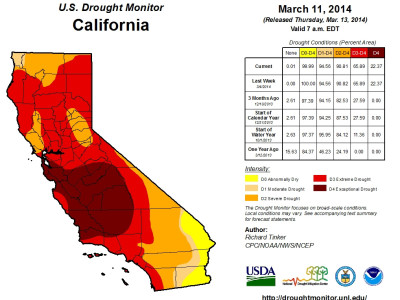The Hydrology of the Public Trust
The Public Trust Doctrine Gives California Regulators the Authority to Monitor Groundwater Pumping
 A couple of weeks ago, Rick reported that California might finally be ready to institute some form of statewide groundwater regulation. (The original California Water Act regulating surface water is now more than 100 years old, and when it was enacted, many observers thought that groundwater regulation was just around the corner: hey, what’s a century between friends?). Consider me skeptical: both bills are currently in suspense in the Legislature. Moreover, the fact that they are tepidly supported by the Association of California Water Agencies, in the words of Shania Twain, don’t impress me much: I’m still waiting for the Farm Bureau and conservative agricultural interests to sign on, and they have already declared their opposition. (I love the reasoning on the Farm Bureau’s web site: groundwater regulation should “not [be] hurried through a legislative process to meet arbitrary deadlines”: it’s been 100 years!). And they are not even very strong bills. Rick noted that neither of the bills with even a decent chance of being enacted require pumpers to monitor and report the volume and rate of their groundwater pumping:
A couple of weeks ago, Rick reported that California might finally be ready to institute some form of statewide groundwater regulation. (The original California Water Act regulating surface water is now more than 100 years old, and when it was enacted, many observers thought that groundwater regulation was just around the corner: hey, what’s a century between friends?). Consider me skeptical: both bills are currently in suspense in the Legislature. Moreover, the fact that they are tepidly supported by the Association of California Water Agencies, in the words of Shania Twain, don’t impress me much: I’m still waiting for the Farm Bureau and conservative agricultural interests to sign on, and they have already declared their opposition. (I love the reasoning on the Farm Bureau’s web site: groundwater regulation should “not [be] hurried through a legislative process to meet arbitrary deadlines”: it’s been 100 years!). And they are not even very strong bills. Rick noted that neither of the bills with even a decent chance of being enacted require pumpers to monitor and report the volume and rate of their groundwater pumping:
It seems quite impossible to develop viable and effective plans to eliminate groundwater overdraft and maintain groundwater aquifer sustainability without knowing who is pumping groundwater from a given aquifer and in what amounts. Why not simply make groundwater pumpers compile and report the same data that most California surface appropriators already do?
Why not? Because the entire point is to make regulation toothless. It’s a feature, not a bug! And even then it hasn’t gotten their support.
There is a way around it, though; ye olde Public Trust Doctrine. Yes, I know: everyone is tired of articles and comments saying how the Public Trust Doctrine can fix this or that grave environmental problem. But it’s quite straightforward here.
The PTD clearly applies to all California surface waters, and gives the State Water Resources Control Board the right to regulate surface water independent of specific statutory authorization. There is no real precedent on whether it applies to groundwater — a hotly debated and contested topic among water buffaloes. But no one denies that as a matter of scientific fact, surface and ground water are intimately linked. This is not always true, but it is very often true. This is so much the case that, as Holly pointed out in July, when a Sacramento court ruled that the PTD applied to groundwater pumping that affects surface waters, it “follow[ed] straightforwardly from the classic Mono Lake case, National Audubon Society v. Superior Court, 33 Cal. 3d 419 (Cal. 1983).” It really was not a stretch at all.
But if regulation of groundwater pumping that affects surface water follows from Mono Lake, it surely must be the case that the SWRCB has the authority to determine whether the groundwater pumping affects surface water in the first place. It makes no sense to say: 1) you have the authority to regulate; but 2) you do not have the authority to find facts that determine whether you can regulate. It thus is fairly straightforward that the authority to require monitoring and report groundwater pumping is inherently within the SWRCB’s purview. The Board does not need authorizing legislation to do this.
It might, however, need the money to do it, which provides another wrinkle. Suppose that a pumper refuses to install monitoring equipment in order to measure pumping. Could the Board do it itself? Perhaps. But if the Board actually installs and retains title to the equipment, then it could quite possibly be a taking under Loretto v. Teleprompter Manhattan CATV Corp., the 1978 US Supreme Court holding stating that a permanent physical invasion of property, no matter how small, is per se a taking under the Fifth Amendment. The Board might be well advised to mandate the installation of the equipment rather than doing it itself. But it will still need money to implement and enforce such regulations.
Rick is this blog’s optimist, and I am the pessimist. I hope I am wrong about the bills he referenced. But in any event, the issues of monitoring and reporting the flow and rate of pumping does not need new legislation. And that could be powerful in and of itself. My colleague Gary Blasi fond of saying that “what gets measured gets managed.” We can hope so.




Reader Comments